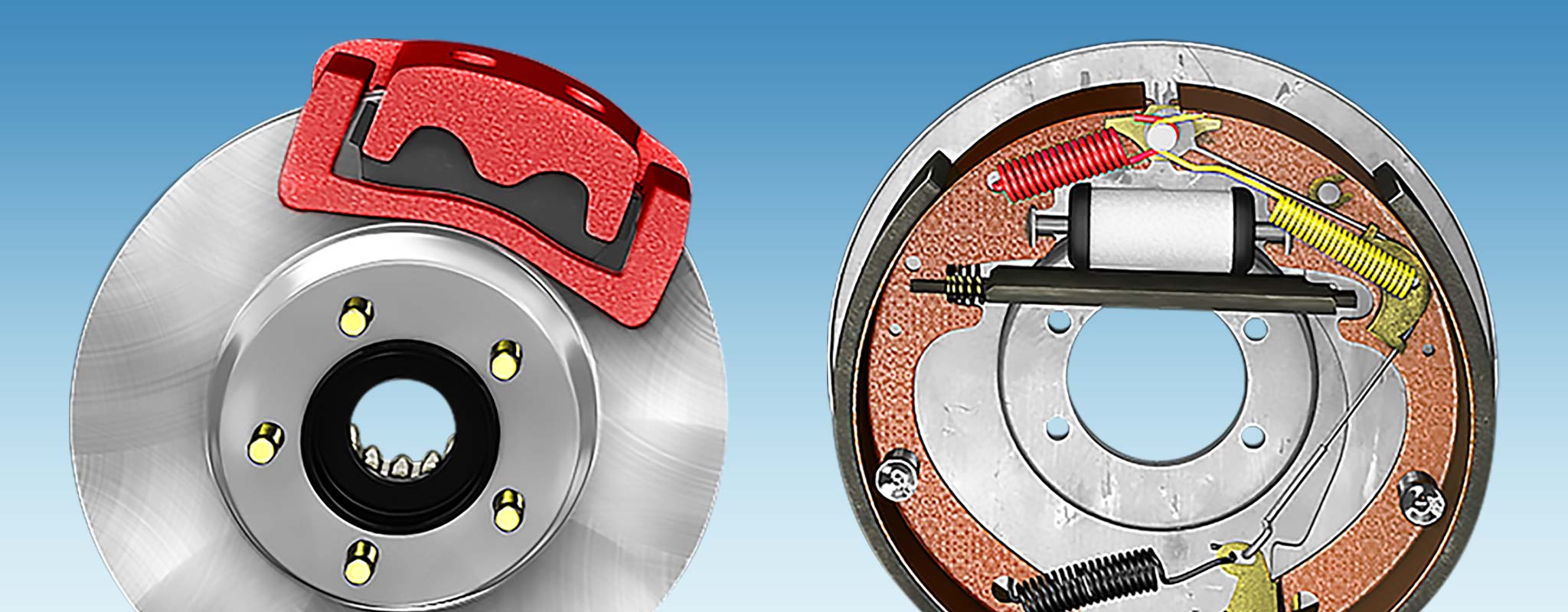Complete Guide to Disc Brakes and Drum Brakes
When it comes to driving safety, your brakes are critical. We’ve compiled a guide to help you understand your brakes. This includes disc and drum brakes, how they work, how they’re different and alike, why you may have both types on the same vehicle, what kind of wear to expect, and what parts will need maintenance.
What you’ll find in this guide:
What Is a Simple Brake System
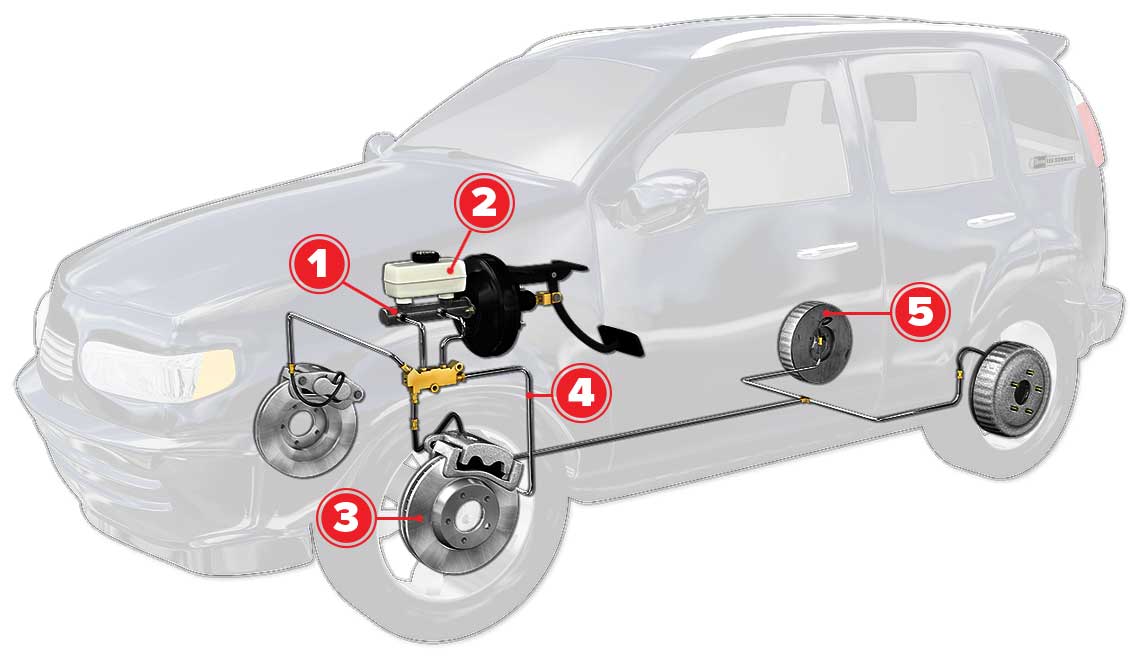
Master Cylinder: Contains a piston assembly and brake fluid.
Brake Fluid: Transfers the hydraulic pressure.
Disc Brake Assembly: Includes caliper, pads, and rotor.
Brake Lines and Hoses: Carries the brake fluid to the brake assemblies.
Drum Brake Assembly: Includes shoes, wheel cylinder and drum.
Braking System Basics
Disc and drum brakes are based on a hydraulic pressure system. Braking starts with a mechanical force — your foot pressing the brake pedal. The end result is that your vehicle safely stops. Below is a quick explanation of the five points of the system.
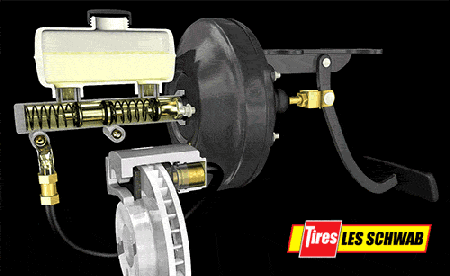
A piston compresses brake fluid inside the master cylinder located under your vehicle’s hood near your engine. This creates hydraulic pressure, generating a much bigger force than that of the small effort of pressing down on the pedal. See above image.
The pressure is transferred via the brake fluid through the brake lines and/or brake hoses (flexible tubes) that connect the lines with brake assemblies at each wheel.
There, wheel cylinders convert that hydraulic pressure back to mechanical force. Brake friction material is pushed against the brake disc or drum, slowing or stopping your vehicle.
The disc brake assembly is designed to safely stop your car when activated. More details about how this works below.
The drum brake assembly, equipped on some vehicles, is also designed to stop your vehicle when other points on the system are activated. More details below.
Basics of Disc Brakes
Disc brakes are found on most vehicles today. They are mounted on the front and/or rear axle. To stop a wheel (and your car), a disc brake uses a caliper fitted with brake pads to grab a spinning disc or rotor.
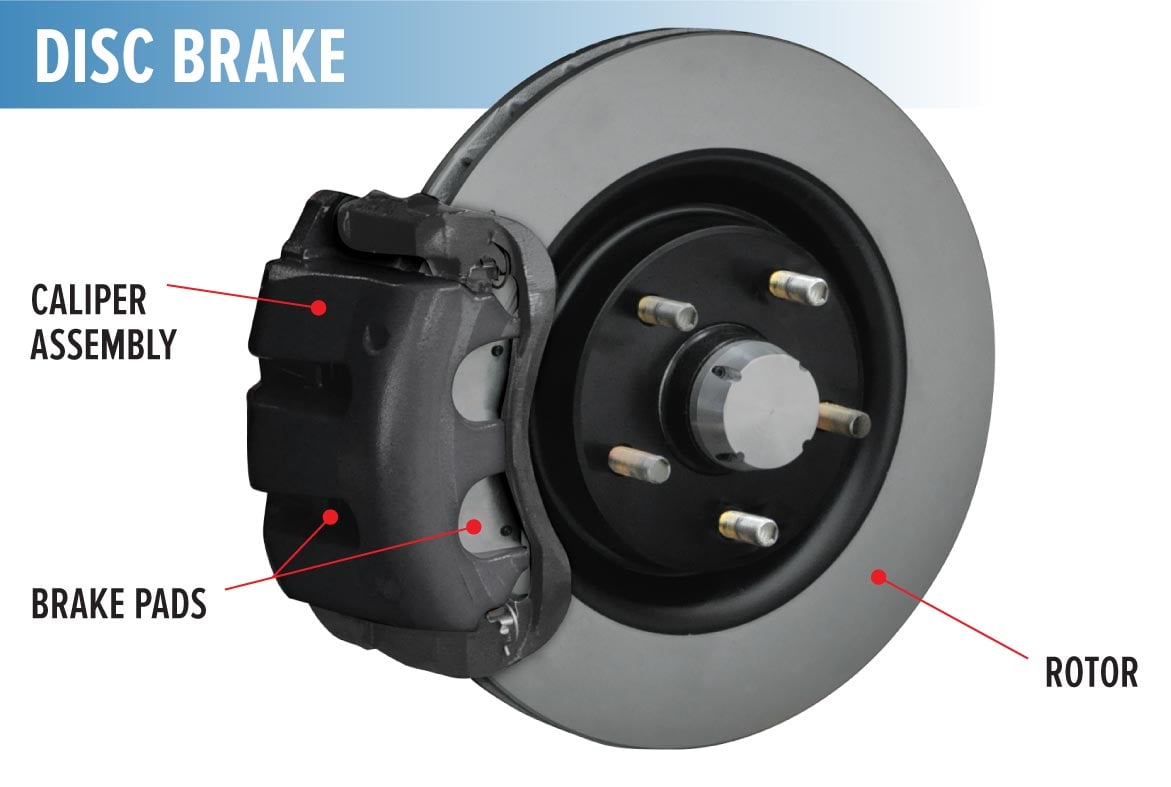
What is a caliper?
The caliper is an assembly mounted to the vehicle with a bracket. It frames the rotor, looking and functions like a c-clamp. It contains the following components:
Brake pads are a friction material bonded to a metal plate that helps stop your vehicle.
One or multiple pistons to push the brake pads against the rotor when you brake.
A bleeder screw to allow for servicing the brakes and replacing the fluid.
A rubber piston seal that prevents brake fluid leakage and retracts the piston when the brakes are released.
A dust boot to keep contaminants out of the cylinder.
Anti-rattle clips that add stability.
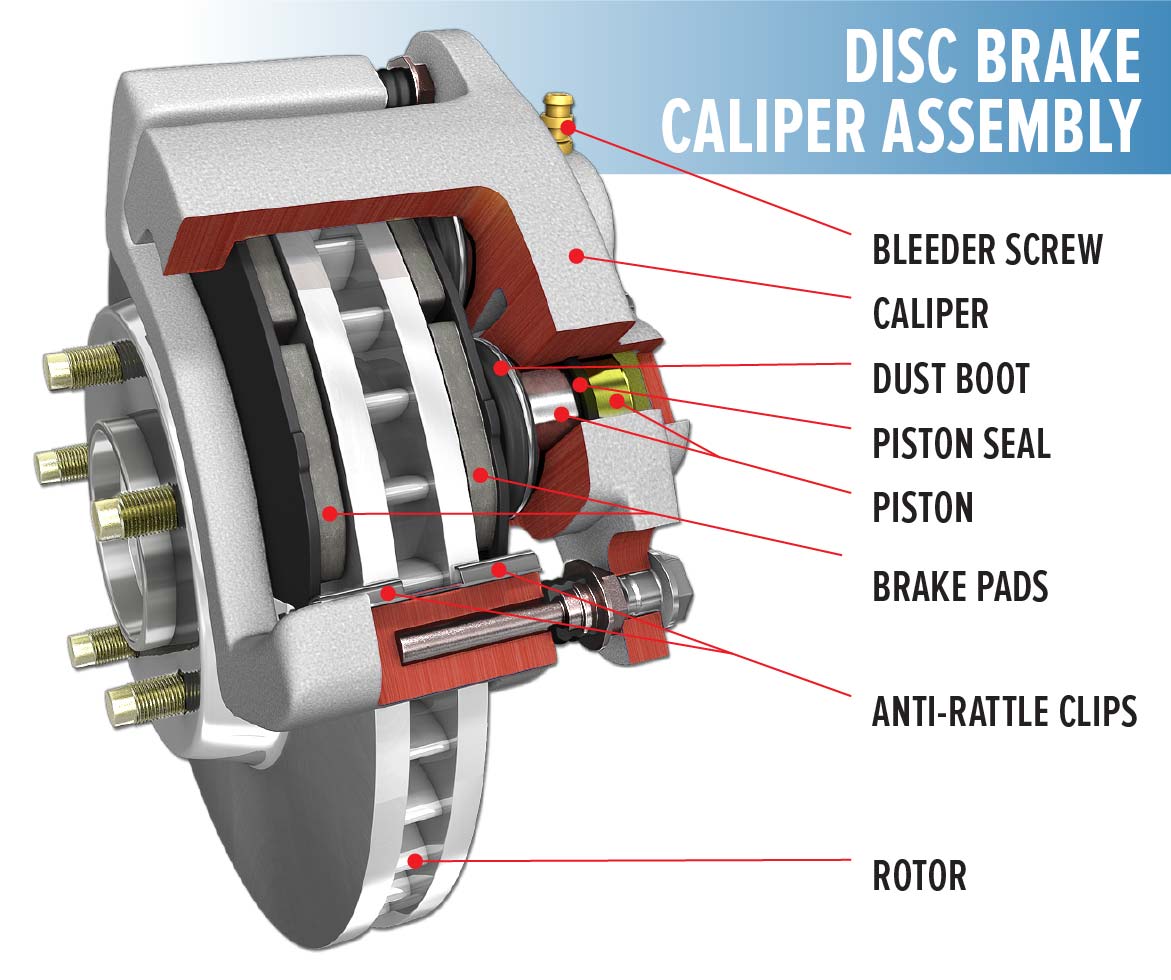
What is a rotor?
The rotor is made of cast iron or a steel/cast iron composite. It’s attached to the wheel hub and turns with the wheel. This is the surface that the brake pads make contact with to slow your vehicle. Here’s how it works: when you step on the brakes, pressurized brake fluid pushes against the pistons inside the caliper, forcing the brake pads against the rotor. As the brake pads press against both sides of the disc, the friction stops the wheel’s rotation.
Rotors can either be solid or vented. Vented rotors have more surface area and can more easily dissipate heat.

Two Types of Disc Brakes: Floating & Fixed
There are two types of disc brakes. They are floating and fixed, named for the type of brake caliper used.
A floating caliper (also called sliding) is the most common type. It has one or two pistons. When the brakes are applied, the inner brake pad is forced against the disc while, at the same time, the caliper body moves closer to the rotor. This action forces the outer brake pad against the rotor.
The fixed caliper design has one or more pistons mounted on each side of the rotor. The caliper itself doesn’t budge or move. It’s rigidly fastened to a brake caliper bracket or spindle. When the brakes are applied, only the caliper pistons move, pressing the brake pads against the disc.
Basics of Drum Brakes
Drum brakes are most often used on the rear axle of today’s vehicles. They are also very common on trailers. Manufacturers don’t use brake pads as the friction material in drum brakes. Instead, a drum brake system has a wheel cylinder with pistons that push brake shoes out against the inside of a spinning drum. This contact slows and stops the rotation of the brake drum and the wheel, bringing your vehicle to a stop.
Drum vs. Disc Brakes
Many of today’s vehicles have disc brakes on all four wheels. However, some models still have disc brakes on the front axle and drum brakes on the rear.
Why are discs put on the front? It’s due to weight factors. A typical, unloaded vehicle is about 10 percent heavier in front due to the engine. When you hit the brakes, the weight of the car transfers to the front. Therefore, more braking power is needed in the front, making disc brakes the perfect option for the job.
Disc vs. Drum Brakes: Servicing
Servicing disc and drum brakes is important. When it comes to repairs, drum brakes have more hardware and can be more complex to service. But the materials typically cost less than disc brake pads, calipers, and rotors. Disc brakes generally consist of fewer components and are easier to service.
Brake Maintenance: What Needs to Be Checked
A lot of heat is created when you apply the brakes. When you press on the brake pedal, you’re converting the kinetic (moving) energy of the vehicle into thermal energy (heat), subjecting many parts to very high temperatures. This means a lot of wear and tear even in normal conditions. Some brake components will need to be replaced over the life of a vehicle, including:
Brake Pad or Brake Shoe Friction Material: Disc brake pads slow the rotor through friction and wear with normal use. Eventually, they become too thin to function properly. The same applies to drum brakes. The friction material gets worn out and braking can become compromised. These components should be inspected regularly to avoid wearing them to the point that they cause damage to additional parts of your vehicle (rotor or drum).
Brake Fluid: The brake system should be checked regularly for leaks and fluid should be replaced every few years (usually when the brakes are serviced). Any leak in the master cylinder, the brake fluid reservoir, the wheel cylinders, lines or hoses will reduce the hydraulic pressure that’s created when the brakes are activated. If the system can’t generate sufficient force needed to create braking power, you’ll notice your brake pedal needs to be pressed a lot further in order to slow or stop.
How often should I replace my brake fluid?: The brake fluid should be replaced every few years. This is usually done when brakes are serviced. While brake fluid is specifically formulated to prevent corrosion of the brake hydraulic components, time, heat, and moisture can lower the boiling point of the fluid. This results in less pressure in the hydraulic system forcing you to push down farther on the brake pedal to slow your vehicle. Other impurities, such as road grime, brake dust, rust, and more can get into the brake fluid, reducing braking efficiency and possibly damaging parts of the braking system.
Seals: These rubber rings keep the hydraulic fluid from leaking and protect it from moisture and contaminants. They also cause the piston to return to its off position so the brake pads disengage properly when you release the brake pedal. If this doesn’t happen, you could experience brake drag, premature wear, and the vehicle may pull to one side when you brake.
Brake Lines/Hoses: Brake lines and hoses are an essential part of the braking system. Rubber hoses can wear over time, while brake lines can be subject to corrosion or other damage. When this happens, it may compromise brake efficiency, loss of hydraulic pressure, pulling to one side, etc. Routine inspections, including hoses and lines, are critical to avoiding these issues.
Rotors: Rotors should be inspected regularly for even wear, physical damage, or cracking from excessive heat. These conditions can compromise braking power and efficiency. Brake rotors should be resurfaced or replaced when you have your brakes serviced (brake job or pads replaced). If you are experiencing any of the previously mentioned issues, your rotors may need to be repaired or replaced sooner.
Dust Boots: Brake components are constantly exposed to road debris and brake dust. The dust boot prevents grime from entering the caliper piston. If it fails and can’t do its job, piston damage can occur, causing brake drag, pulls and premature wear.
Master Cylinder: Regular fluid maintenance is important for prolonging cylinder life. Failing master cylinders can leak internally. In this case, you may get a low or soft pedal feel. You might not notice any visible fluid loss.
NOTE: There are different approaches to brake service. See our Brake Servicing 101 and learn why it’s important to maintain more than just the brake pads or drum brake shoes.
How Often Do Brakes Need to Be Serviced?
There’s no set timeframe. The need to replace or service your brakes depends on your vehicle, driving style, climate and road conditions. To ensure proper braking when you need it, get your brakes checked regularly.
Still have questions about your brakes? Learn more about brake servicing and inspections here.
Takeaways
Disc and drum brakes are built differently, with somewhat different advantages. Both work as part of the hydraulic brake system. This system is constantly under high pressure, subject to heat, and can be compromised by road grime, air, brake dust and moisture. It’s important to get regular brake inspections to keep everything in proper working condition. Refer to your owner’s manual for a recommended schedule. Remember that odd brake sounds, smells or performance are indicators you need to get your vehicle to Les Schwab right away.
What you need to know
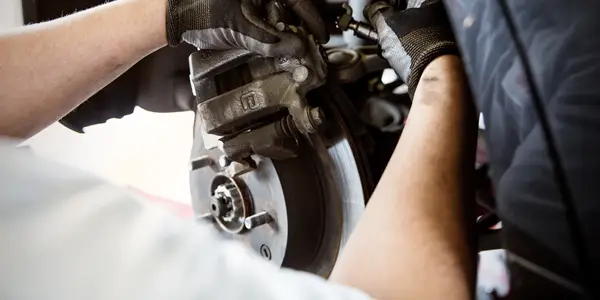
Brake Servicing & Inspection: Choosing the Right Place for Your Car
Ensure your vehicle’s safety with regular brake maintenance. Learn what to look for before servicing to ensure fair treatment and quality work.
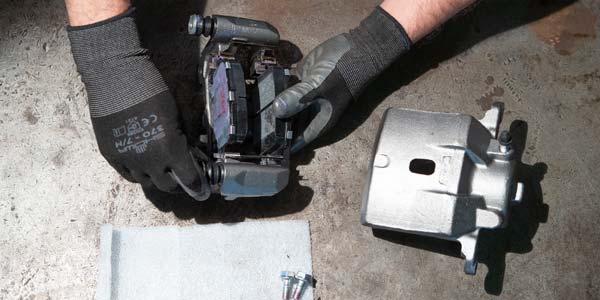
Why We Replace Calipers With Your Brake Service
When brakes wear out, you want to replace more than just the worn-out brake pads. Here’s why we replace brake calipers as part of our brake service.
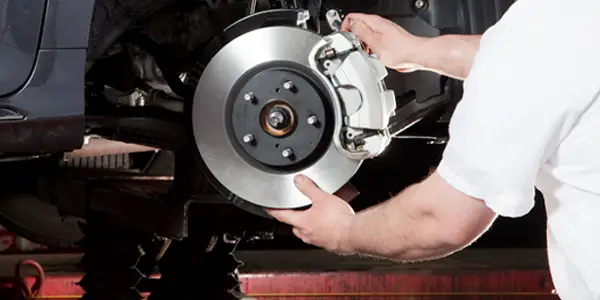
Understanding Brake Shoes vs. Brake Pads
Understand the differences between brake shoes vs. brake pads and what each of these brake components do to maintain your safety on the road with this Les Schwab guide.

